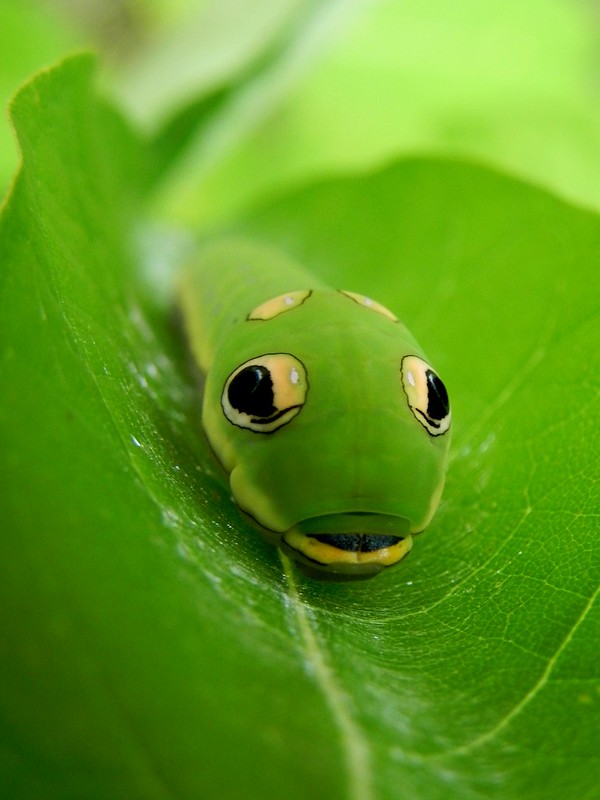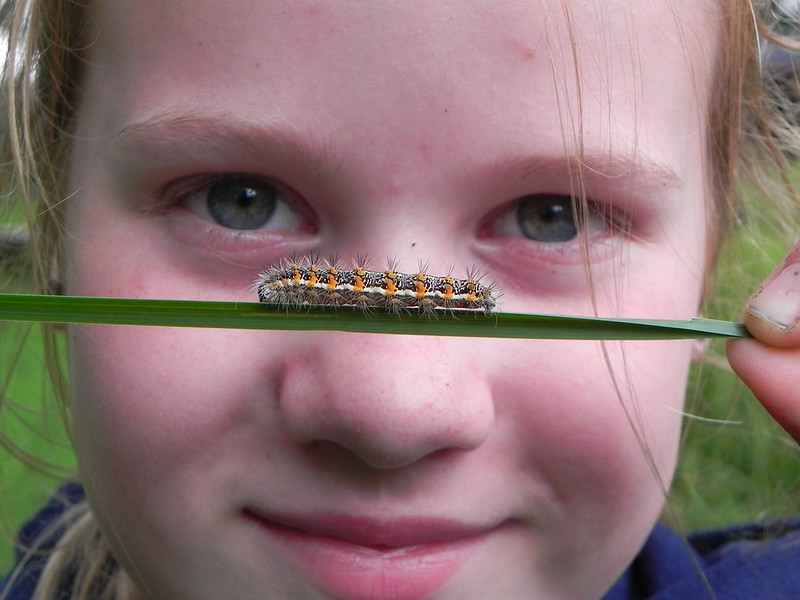If there was any doubt about the diversity of life on Earth, one just need look at caterpillars. The variety of colors, shapes, and pattern of different species is astounding. It is estimated that east of the Mississippi, there are approximately 5,000 different species of butterflies and moths. Also called Lepidoptera, they move through the larva stage we call caterpillars.
Many of these caterpillars are large and noticeable. During these warm summer days, as the energy of the sun is captured by green and growing leaves, caterpillars abound. They are munching, munching, munching on leaves. These secondary consumers of sunshine are found on flowers and food plants, high in the trees or moving among the leaf litter.

A flip through a caterpillar field guide reveals many interesting common names. Some names are familiar. Monarch. Eastern Tiger Swallowtail. Luna. Some names are descriptive. Silvery Checkerspot. Monkey Slug. Black-Waved Flannel. Other names seem other-worldly, engaging your imagination and questioning the motives of those that bestowed these names. Faithful Beauty. Turbulent Phosphila. Distinct Quaker.
Each of these caterpillars has its own strategies for survival. Some camouflage themselves among their food. Several caterpillars are leaf green. Others such as inchworms and others in the Geometridae family are brown and rest outstretched looking very much like a small twig attached to a branch. A master of disguise is the Spicebush Swallowtail. When young, the caterpillar mimics bird droppings on the surface of a leaf. As it grows the disguise changes. Later stages, or instars, roll up in a leaf, leaving their head, with large eye spots, slightly visible. They are said to look like a snake. If that’s not enough, they can display otherwise hidden osmeterium if disturbed. These are two orange, antenna-like structures that emerge from the head with a chemical that may repel predators.
For all the unique traits caterpillars share much in common. They are all only one part of a larger lifecycle. As the larva of butterflies and moths, they emerge from the egg as eating machines. Most are herbivores but not all. There are a few carnivorous caterpillars, including the Harvester caterpillar. It is found on alder and other bushes and trees. Rather than eating the leaves, it eats the wooly aphids that are present feeding on the sap of the plant. Often the caterpillar then uses “wooly” secretions from the dead aphids to disguise itself among the aphid colony.
Voracious eaters, caterpillars grow exponentially, some 1,000 times their original size. The largest grower is the Polyphemus Moth. As a caterpillar it grows to 85,000 times its own weight. All in a few weeks! As they grow, they shed their skin five to six times in their short life. While outrageous, this eating is critical. The energy obtained from all this eating will sustain them through the pupae stage into adulthood. Some moths, such as Luna Moth, emerge from the cocoon without functioning mouth parts. They don’t eat as adults.

Caterpillars can be a gateway into the world of insects. They are attractive but also weird and fascinating. Fairly easy to keep in captivity, many elementary students raise and release caterpillars and butterflies. Not only are caterpillars the ideal lifecycle lesson, their metamorphosis can be used as a metaphor for that uncomfortable but necessary change that we all go through at some point in our lives. When faced with an unforeseeable future, we look to the mysterious change of caterpillar to butterfly (or moth) for inspiration.
When found outside, they are fairly easy to catch and observe. A warning to those caterpillar hunters. Other methods of defense against predators include hairs and spines. Some hairy caterpillars can irritate human skin when touched. The spines, filled with a poison, are a little worse. When doing some yard work, I came across an Io Moth caterpillar. Not knowing, I picked it up to hold — but not for long. The immediate, sharp sting in the palm of my hand, which lasted for at least an hour was the result of being pierced with those spines. So if it’s got hair, beware.
The very feeding that is critical to caterpillar survival results in some caterpillars becoming pests when their populations are high. Gypsy Moth caterpillars can defoliate a hardwood forest. The Cabbage Butterfly caterpillar feeds on broccoli, cauliflower and other plants in the cabbage family. A small group of the caterpillars devastated my small crop of kale so image what they would do to a farm field of kale. I’ve been at war with pantry moths in my kitchen and put out moth balls to prevent clothes moths eating sweaters.

Despite the downside of caterpillars, they are an extremely important part of the food chain. Caterpillars are a major food source for birds. The protein from caterpillars fuels the growth of many hatchling songbirds. Scientists estimate that one Red-eyed Vireo eats about 50,000 caterpillars per season. When caterpillars do have the chance to become moths or butterflies, they have a niche too. Moths are a food source for bats and nocturnal birds. The entire silk industry was built off of dissolving the cocoon of silkworms to weave into fabric. And butterflies are important pollinators as they move from flower to flower to feed.
ACNC’s trails twist through many habitats, all the better for going on a caterpillar hunt of your own. A good camera can capture both the field marks of the larvae and the host plant it is feeding on, which will help with identification when you return home. There are some caterpillar field guides in the Blue Heron Gift Shop. And there are many sites to find information online.
Katie Finch is a nature educator at Audubon.
Audubon Community Nature Center builds and nurtures connections between people and nature. ACNC is located just east of Route 62 between Warren and Jamestown. The trails are still open from dawn to dusk as is Liberty, the Bald Eagle. The Nature Center, while currently closed due to COVID-19 restrictions, will partially reopen on September 5 including restrooms and the Blue Heron Gift Shop and some exhibits. More information can be found online at auduboncnc.org or by calling (716) 569-2345.


Recent Comments